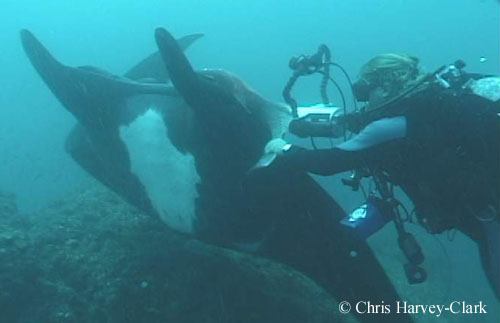Atlantic Manta
Manta birostris
Description
The Atlantic manta is a distinctly shaped batoid, due in part to its pelagic lifestyle. It has a wide, dorso-ventrally flattened body; a very long, whip-like tail longer than the body that tapers into a lash-like tip; and a broad, dorsally flattened (or slightly convex) head distinct from the disc formed by the trunk and the enlarged pectorals. The mouth of the Atlantic manta is terminal or subterminal and nearly straight, with the roof containing a broad transverse curtain that is either smooth-edged or finely fringed at the margins. The teeth of the Atlantic manta are minute and the eyes and spiracles - which are lateral on either side of the head - are small. Each broad pectoral fin is divided anteriorly at the head to form two widely separated cephalic fins that curve forward from the front of the head flanking the mouth. A single, small dorsal fin is present on the base of tail, whereas the caudal fin is absent. The skin of the Atlantic manta is smooth and lacking scales, although some small prickles are sometimes present. Colouration on the dorsal surface varies from reddish to olivaceous brown to black on the dorsal surface, with or without white markings, whereas the ventral surface is white toward centre of disc and gray around the margins, occasionally with various dark blotches near the gills and on the abdomen. The rear part of the tail is gray in colour.
Size
The maximum disc width attained by Atlantic mantas is approximately 6.1 m. The maximum recorded weight is 1360 kg.
Range
Atlantic mantas occur in the western Atlantic generally from the Carolinas south as far as Brazil. They are also found in waters around Bermuda, Madeira and tropical West Africa. They are very rarely found in colder waters of the northwest Atlantic; however, strays have been caught in southern New England and Georges Bank waters.
Habitat
The Atlantic manta occupies surface or near surface waters, progressing through the water column by flapping its enlarged pectorals in a wing-like motion.
Life History
Unknown
Diet
The food of the Atlantic manta consists of small pelagic organisms such as smaller schooling fishes and planktonic crustaceans, where are sometimes funneled into the mouth with the aid of the large cephalic fins on either side of the head. Water exits through the gill plates. Aerial displays are not uncommon among mantas, and may be a result of active prey pursuit.
Reproduction
This batoid is ovoviviparous, bearing live young.
Interaction with people
The Atlantic manta is on no economic importance. However, it is a prized sportfish and is also sought after by divers.
Common Names
Also known as devil rays or devil fish.
- Date modified:
